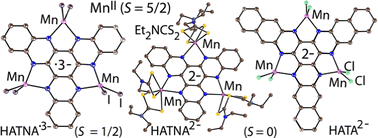Manganese(ii) complexes of hexaazatrinaphthylene and hexaazatrianthracene: synthesis, structure and properties†
Abstract
Complexes of high-spin (S = 5/2) manganese(II) with hexaazatrinaphthylene (HATNA) and hexaazatrianthracene (HATA) dianions and radical trianions have been obtained in a crystalline form. Neutral HATNA is coordinated with only one MnII(dedtc)2 fragment (dedtc: diethyldithiocarbamate) in [{MnII(dedtc)2}(HATNA)]0 (1) with long MnII–N(HATNA) bonds of 2.390(5) Å. The HATNA dianions are coordinated with three MnII(dedtc)2 or MnII(acac)2 units in {(K+)(crypt)}2[{MnII(dedtc)2}]3{(HATNA)}2−·2C6H4Cl2 (2) and {(K+)(crypt)}2[{MnII(acac)2}3{(HATNA)}]2−·2C6H4Cl2·C6H14 (3) (crypt is cryptand[2.2.2]) with shorter MnII–N(HATNA) bonds of 2.252(3) and 2.287(4) Å length, respectively. The MnII–N(HATA or HATNA) bonds are shortened to 2.160(4) and 2.110(4) Å in dianionic (CV+)2[(MnIICl2)]3{(HATA)}2−·4C6H4Cl2 (4) and trianionic {(K+)(crypt)}3 {(MnIII2)3(HATNA)}3−·5C6H4Cl2 (5) complexes, respectively (CV+ is a crystal violet cation). It is shown that the MnII–N bonds in 1–5 are longer in comparison with the FeII–N and especially CoII–N bonds. Weak antiferromagnetic MnII–MnII coupling with J values of −1.98 and −2.70 cm−1 is observed for diamagnetic ligands in 2 and 4. The paramagnetic HATNA˙3− ligand (S = 1/2) leads to the additional antiferromagnetic MnII–HATNA˙3− coupling with a J value of −6.6 cm−1 in 5, which coexists with weaker MnII–MnII coupling with a J value of −0.6 cm−1. As a result, the χMT value in 5 only weakly depends on temperature. Thus, the MnII–HATNA˙3− and MnII–MnII couplings are noticeably smaller than those in previously studied CoII and FeII assemblies. Zero-field splitting parameter D is rather high for manganese(II) ions in 2, 4 and 5 being −3.1 to −4.6 cm−1. Weaker exchange coupling allows the observation of both EPR signals from MnII and the paramagnetic ligand. An isotropic EPR signal from MnII with a g-factor of 2.03–2.04 is observed in 2 in the whole studied temperature range. An isotropic EPR signal is also observed in 4 with g = 2.0346 at 295 K. This signal shifts to a lower g-factor at 100 K, whereas low-field components appear only at 4.5 K. The contribution from HATNA˙3− in 5 probably decreases the g-factor to 2.0017 at 295 K. Zero-field splitting of the EPR signal for MnII is manifested at 4.2 K.



 Please wait while we load your content...
Please wait while we load your content...